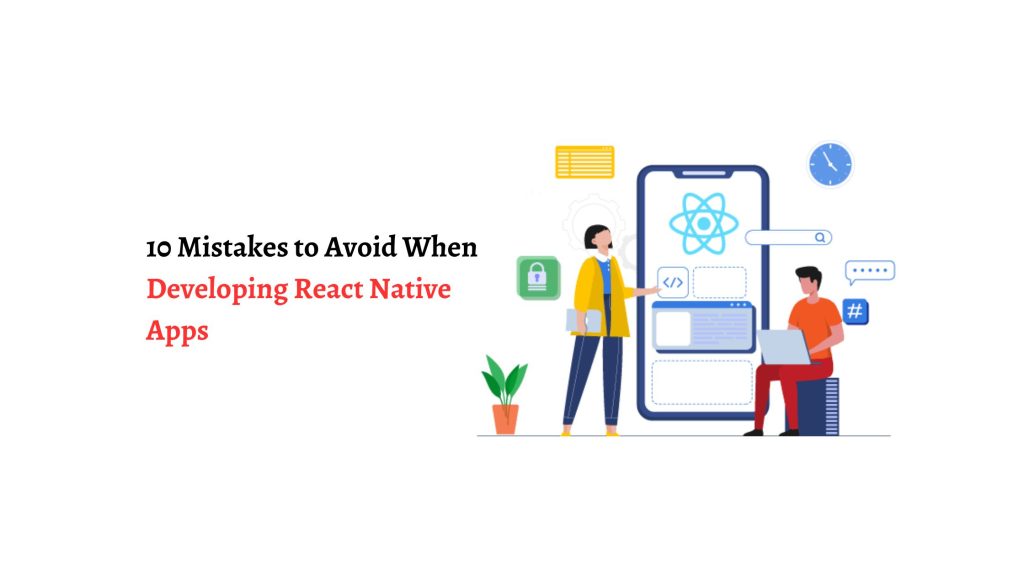10 Mistakes to Avoid When Developing React Native Apps

Have you noticed how mobile and web applications have integrated into our daily lives? This booming industry offers aspiring companies a promising business opportunity to create standout applications.
However, app development is complex and requires crucial decisions for your business. One of the first steps is selecting the right programming tool to ensure a smooth user experience. Therefore, many companies are turning to React Native for its ability to build cross-platform applications. To gain a competitive edge, businesses often seek to hire a reliable React Native app development company.
Despite its advantages, developing apps with React Native presents its own set of challenges. From optimizing performance to considering platform-specific nuances, avoiding common pitfalls is essential for the success of your React Native projects.
Common React Native App Development Mistakes to Avoid
Mistake 1: Not Optimizing Performance
Issue: A common pitfall in React Native app development is neglecting performance optimization. Unoptimized images, inefficient component rendering, and unnecessary re-renders can result in sluggish user experiences and decreased app performance.
Solution: To tackle performance issues, developers should focus on optimizing images, efficient rendering, and minimizing redundant component updates.
Mistake 2: Ignoring Platform Differences
With React Native framework, your developers can create apps with a single codebase for various platforms. However, not paying attention to differences between the platform’s UI/UX and features can lead to inconsistencies.
Solution: Developers should adhere to platform-specific design guidelines to ensure a tailored UI/UX experience.
Mistake 3: Neglecting Testing
Issue: Skipping proper testing in React Native app development can lead to unidentified bugs, reduced code stability, and poor app quality. Without thorough testing, developers risk deploying apps with critical issues that can negatively impact user experience.
Solution: Prioritize testing throughout the development process by leveraging frameworks like Jest and Enzyme.
Mistake 4: Inadequate Error Logging and Reporting
Issue: Neglecting robust error logging and reporting can make diagnosing and resolving issues in React Native apps challenging.
Solution: Implement a comprehensive error logging and reporting system that captures errors, warnings, and critical events in the app.
Also read How Much Does React Native App Development Cost?
Mistake 5: Disregarding Protocols
Issue: Ignoring protocols in React Native app development can lead to many issues like:
- Compatibility issues
- Security vulnerabilities
- Integration difficulties.
Failure to adhere to established communication standards can result in data exchange errors, security breaches, and limited functionality.
Solution: Developers should research, understand, and implement relevant protocols.
Mistake 6: Neglecting Project Structure
Issue: An unoptimized project structure in React Native app development can lead to disorganized code, which results in:
- Difficult to navigate the app
- Maintain and scale features
- Increased development time
- Higher complexity
- Decreased code quality
Solution: Establish a well-defined project structure from the outset, organizing files and directories logically and consistently.
Mistake 7: Lack of Offline Support
Issue: Failing to implement offline support in React Native apps can lead to a poor user experience. Without offline functionality, users may become frustrated when unable to access app features or content offline.
Solution: To guide users when offline, you can provide user-friendly error messages and implement retry mechanisms for failed network requests.
Mistake 8: Not Considering Accessibility
Issue: Ignoring accessibility in React Native app development can exclude users with disabilities, leading to pitfalls like:
- Potential legal issues
- Less inclusivity
- Less engagement
- Unhandy app experience
Solution: Follow accessibility guidelines like WCAG. Also, ensure your app is usable by individuals with diverse needs with React Native’s built-in accessibility features.
Mistake 9: Overlooking Internationalization and Localization
Issue: Not focusing on internationalization and localization can limit the reach and user adoption of a React Native app in global markets, missing opportunities and reducing user engagement.
Solution: Implement internationalization and localization strategies to make your React Native app accessible to users worldwide.
Mistake 10: Neglecting External Module Code
Issue: Failing to thoroughly review and understand the code of external modules or libraries used in React Native app development can lead to compatibility issues, security vulnerabilities, and limitations in customization.
Solution: Thoroughly read and understand the code of external modules, review documentation, and study implementation details. Follow secure coding practices and verify compatibility with your existing codebase to avoid introducing bugs or errors.
Conclusion
When launching your React Native apps, avoid common mistakes to ensure a smooth and reliable product. And opting for professional React Native app development services can help your business establish a strong presence in the market.
Moreover, partnering with experienced developers ensures your app is built to high standards, helping you achieve success.
Read more Technology





